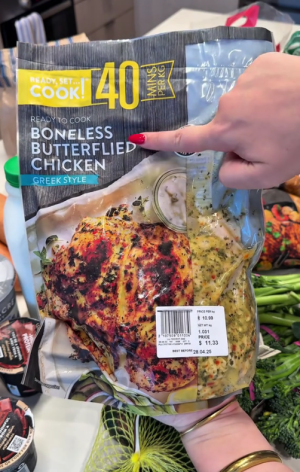This woman traded Woolworths for ALDI and saves $70 a week! Find out her emotional budget secret!
By
Gian T
- Replies 0
As the cost of living continues to rise, many Australians are feeling the pinch when it comes to their weekly grocery bills. For those over 60, managing a budget can be particularly challenging, with fixed incomes and the need to stretch every dollar further. It's no wonder that stories of savvy shopping and significant savings catch our attention here at the Seniors Discount Club.
One such story is that of Bronte Lang, a former self-confessed 'Woolies snob,' who has made a dramatic shift in her shopping habits, resulting in substantial savings. Bronte, a 26-year-old marketer and content creator, shared with Yahoo Finance her emotional journey from loyalty to Woolworths to becoming an ALDI convert. The reason for her switch? A staggering $70 a week in savings.
Bronte's tale is a familiar one. Many of us have our preferred supermarkets, often chosen for their range, familiarity, or perceived quality of products. However, with grocery costs soaring, Bronte and her partner were left feeling disheartened every time they checked out at Woolworths, with their bill averaging around $250. 'Every time we had a grocery shop, we just kind of wanted to cry a bit,' she admitted.
The turning point came when an Aldi store opened conveniently down the road from her. Initially drawn in by ALDI's Special Buys, Bronte decided to give the German discount chain a try. The result? A significant drop in her weekly grocery bill, now averaging about $180, covering all meals for the week. 'I do find it is cheaper,' she said, noting that meat, in particular, offered more bang for her buck at Aldi.
Bronte's experience isn't unique. Many Australians are discovering that ALDI's smaller range of products—around 1,800 compared to the 20,000 to 25,000 at Coles and Woolworths—doesn't necessarily mean a compromise on quality. In fact, a government-funded supermarket price report by CHOICE found that a basket of 14 essential items was $15.98 cheaper at ALDI than at Woolworths.
But it's not just about switching supermarkets. Bronte also emphasises the importance of smart swaps and avoiding brand names when possible. Home products like cleaning supplies and toilet paper, she points out, can be just as good from ALDI and come with a lower price tag.
Despite the savings, Bronte and her partner still visit Woolworths for specific items they prefer, such as Mexican seasoning. The convenience of having both stores nearby allows them to maximise their savings while still getting everything they need.
For our members who are considering a similar switch, it's worth noting that ALDI's approach to cost-saving extends to its operations. With fewer staff and smaller stores, ALDI can pass on savings to customers. However, they don't offer online shopping and are not present in Tasmania or the Northern Territory.
Grocery spending in Australia reached a record high in January, with households reporting an average weekly spend of $209, up from $188 the previous year. With four in five Aussies actively looking to cut their grocery bills, strategies like shopping at multiple stores, switching to cheaper brands, meal planning, and meal prepping are becoming increasingly common.
Bronte's story is a testament to the power of being open to change and the benefits of shopping around. While she's found a way to save without sacrificing quality, it's a reminder that each of us can take steps to manage our grocery spending better.
We'd love to hear from you, our Seniors Discount Club members. Have you found ways to save on your grocery bills? Do you have a favourite supermarket, or do you shop around? Share your tips and experiences in the comments below, and let's help each other navigate the ever-changing landscape of grocery shopping.
Credit: TikTok

One such story is that of Bronte Lang, a former self-confessed 'Woolies snob,' who has made a dramatic shift in her shopping habits, resulting in substantial savings. Bronte, a 26-year-old marketer and content creator, shared with Yahoo Finance her emotional journey from loyalty to Woolworths to becoming an ALDI convert. The reason for her switch? A staggering $70 a week in savings.
Bronte's tale is a familiar one. Many of us have our preferred supermarkets, often chosen for their range, familiarity, or perceived quality of products. However, with grocery costs soaring, Bronte and her partner were left feeling disheartened every time they checked out at Woolworths, with their bill averaging around $250. 'Every time we had a grocery shop, we just kind of wanted to cry a bit,' she admitted.
The turning point came when an Aldi store opened conveniently down the road from her. Initially drawn in by ALDI's Special Buys, Bronte decided to give the German discount chain a try. The result? A significant drop in her weekly grocery bill, now averaging about $180, covering all meals for the week. 'I do find it is cheaper,' she said, noting that meat, in particular, offered more bang for her buck at Aldi.
Bronte's experience isn't unique. Many Australians are discovering that ALDI's smaller range of products—around 1,800 compared to the 20,000 to 25,000 at Coles and Woolworths—doesn't necessarily mean a compromise on quality. In fact, a government-funded supermarket price report by CHOICE found that a basket of 14 essential items was $15.98 cheaper at ALDI than at Woolworths.
But it's not just about switching supermarkets. Bronte also emphasises the importance of smart swaps and avoiding brand names when possible. Home products like cleaning supplies and toilet paper, she points out, can be just as good from ALDI and come with a lower price tag.
Despite the savings, Bronte and her partner still visit Woolworths for specific items they prefer, such as Mexican seasoning. The convenience of having both stores nearby allows them to maximise their savings while still getting everything they need.
For our members who are considering a similar switch, it's worth noting that ALDI's approach to cost-saving extends to its operations. With fewer staff and smaller stores, ALDI can pass on savings to customers. However, they don't offer online shopping and are not present in Tasmania or the Northern Territory.
Grocery spending in Australia reached a record high in January, with households reporting an average weekly spend of $209, up from $188 the previous year. With four in five Aussies actively looking to cut their grocery bills, strategies like shopping at multiple stores, switching to cheaper brands, meal planning, and meal prepping are becoming increasingly common.
Bronte's story is a testament to the power of being open to change and the benefits of shopping around. While she's found a way to save without sacrificing quality, it's a reminder that each of us can take steps to manage our grocery spending better.
We'd love to hear from you, our Seniors Discount Club members. Have you found ways to save on your grocery bills? Do you have a favourite supermarket, or do you shop around? Share your tips and experiences in the comments below, and let's help each other navigate the ever-changing landscape of grocery shopping.
Credit: TikTok
Key Takeaways
- A loyal Woolworths shopper has found significant savings by switching to ALDI, citing reduced grocery bills and smart swaps for generic brands.
- Bronte Lang and her partner save approximately $70 a week, now spending an average of $180 weekly for their groceries at ALDI.
- Many customers echo the sentiment that ALDI offers better value for money, though some still shop at other supermarkets for specific items.
- A report by CHOICE revealed that, for a basket of essential items, ALDI was significantly cheaper than Woolworths, Coles, and IGA due to factors such as a smaller product range and more streamlined operations.








